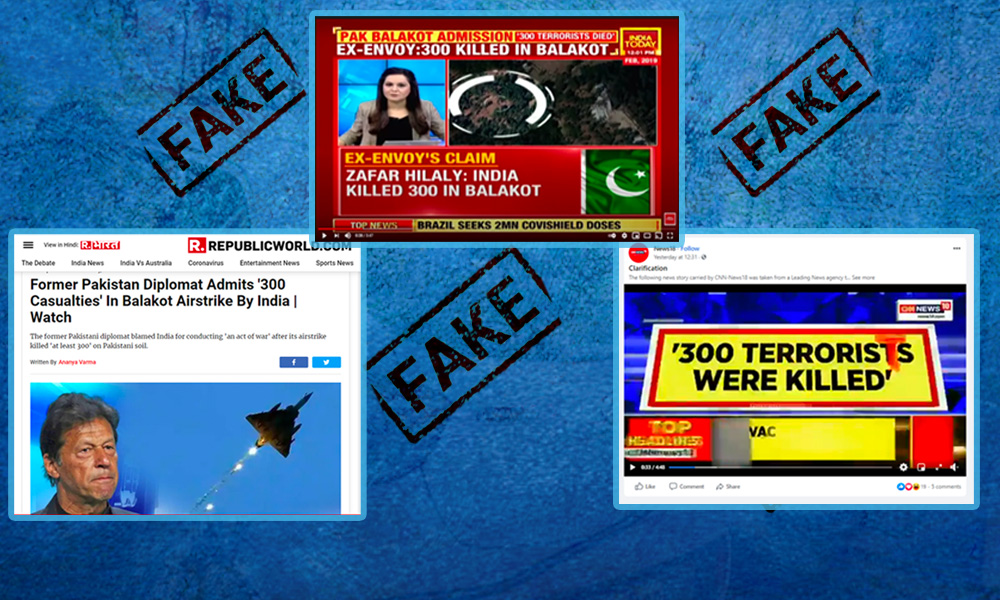
Fact Check: Indian Media Falsely Reports "Ex-Pak Diplomat Admits 300 Killed In Balakot Strike"
Writer: Yusha Rahman
Yusha, an engineer turned journalist with a core interest in sensible journalism. Since the time she worked in an MNC, she saw how fake news was rife to malign images of communities, leaders, etc. This encouraged her to give up her career in MNC and passionately work towards curbing fake news and propaganda.
India, 11 Jan 2021 11:19 AM GMT
Editor : Bharat Nayak |
As the founding editor, Bharat had been heading the newsroom during the formation years of the organization and worked towards editorial policies, conceptualizing and designing campaign strategies and collaborations. He believes that through the use of digital media, one could engage the millennial's in rational conversations about pertinent social issues, provoking them to think and bring a behavioral change accordingly.
Creatives : Rajath
A free spirit who find meaning in life with the virtue of creativity and doing job par its excellence, animal lover and traveller by heart.
Multiple mainstream Indian media channels falsely reported that former Pakistani diplomat in a debate accepted that 300 people were killed in Balakot strike. The video was edited.
On January 9, 2021, multiple mainstream Indian media houses reported that former Pakistani diplomat accepted that 300 people were killed in Balakot surgical strike done by India. India Today, CNN News 18, Republic Bharat, Times of India and many other media houses reported that a former Pakistani diplomat, Zafar Hilaly in a TV debate admitted that 300 people were killed in 2019's Balakot strike. The media reported that Hilaly in a TV debated said, "India crossed the international border and did an act of war in which at least 300 were reported dead. Our target was different from theirs. We targeted their high command. That was our legitimate target because they are men of the military. We subconsciously accepted that a surgical strike -- a limited action -- did not result in any casualty. Now we have subconsciously told them that, whatever they will do, we'll do only that much and won't escalate."
Balakot Strike:
On February 26, 2019, the Indian Air Force did an airstrike at the de facto border in the disputed region of Kashmir as a retaliation to Pulwama attack that happened on February 14, 2019, in which 40 CRPF personnel were killed. The IAF dropped bombs in the vicinity of the town of Balakot in Khyber Pakhtunkhwa province in Pakistan.
Media houses during the Balakot strike had reported that over 300 'militants' were killed in the airstrike. However, foreign media houses refuted the claim, saying no lives were lost in the airstrike. According to the BBC, only one house was damaged slightly, some trees were fallen and a man was injured in the Balakot strike.
Claim:
Ex Pakistani diplomat in a debate accepted that 300 people were killed in the Balakot strike.
Fact Check:
Republic Bharat had attributed its story to a Twitter user, Maverick Bharat, who had posted a video of a TV debate in which Hilaly was making the remark.
Former Pak Diplomat Zafar admitted On Tv that in Balakot airstrike 300+ Terr0rists kiIIed and response of Pakistan was weak.pic.twitter.com/EKYGGuC9dS
— Maverick Bharat (@Mave_Intel) January 9, 2021
On searching with the appropriate keywords, we found the full version of the video which was uploaded on YouTube by Hum News on December 23, 2020. The video was shared by Hum News with the caption, "Program Agenda Pakistan with Amir Zia."
In the video at around 4:16 minutes, one can hear Hilaly speak. He says,"Aapne aake ek madrasa ko, bakaul aapka intention ye tha ki ek madrasa mein jis mein 300 bachche bakaul aapke padh rahe the, udhar aake aapne strike karna tha. Iske maane 300 logo ko maarne ka irada rakha tha aapne. Vo the nahi, vo galat tha, vo hua nahi. Isliye ek football field mein jaake apna bomb phek diya humne. (It is said that your (India's) intention was to strike at a madrasa where 300 children were studying. This means that your (India's) intention was to kill 300 people. They were not there, this was wrong, the strike did not happen so you threw your bomb in a football field.)"
We found that in the viral video, there is an abrupt editing done at around 0:7-0:9 seconds. Hence, when he says "marna (to kill)" it sounds as if Hilaly said "mara (killed)". The pronunciation of 'n' has been edited out. Moreover, in the viral video, the statement by Hilaly where he says that the plan did not work out and hence they bombed a football field, was also edited from the video.
We compared a screenshot of viral video and edited video. On comparison, we found out that the viral video is inverted and screen-recorded. Also, the original video shows the damaged trees of Balakot in the bottom of the screen; while the viral video showed the image of Prime Minister Narendra Modi in Indian Army's uniform. Moreover, in the viral video, all the tickers were removed, while it is present in the original video.
Later Zafer Hilaly refuted the claim. In his tweet, Hilaly called out The Times of India for publishing a story based on an edited video. He also tweeted his original video.
The Times Of India has an item based on the cut, spliced and edited tape of my Hum TV talk. Lacking first hand proof re Balacot, Modi is desperate for 3rd party confirmation for his lies and, not finding any, is doing a terrible job making it up.
— Zafar Hilaly (@ZafarHilaly) January 10, 2021
The extraordinarily extent to which the Indian Govt has gone to cut, splice and edit the tape of my Hum TV appearance suggests their desperation to prove what they failed to do, namely, lend credence to Modi's lies about Balacot and his farcical claims.
— Zafar Hilaly (@ZafarHilaly) January 10, 2021
— Zafar Hilaly (@ZafarHilaly) January 9, 2021
Many Indian media houses later took down the report of former Pakistani diplomat admitting 300 people killed in Balakot strike. CNN News 18 later put out a clarification on the video saying, "The following news story carried by CNN-News18 was taken from a leading News agency that had reported that Agha Hilaly made the statement during a TV new debate on a Pakistani Urdu channel. However, the information has turned out to be false as the video clip cited by the Agency was doctored. The inadvertent error is deeply regretted."
Asian News International (ANI), a media agency that offers syndicated multimedia news feed to multiple news-bureaus in India and beyond, has earlier covered the story which was distributed to multiple media houses. Later ANI took down the news article without giving any clarification.
The claim was earlier debunked by Altnews.
If you have any news that you believe needs to be fact-checked, please email us at factcheck@thelogicalindian.com or WhatsApp at 6364000343.
 All section
All section














